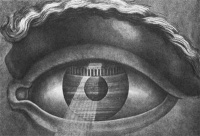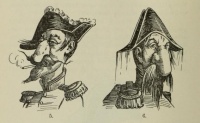Sense
From The Art and Popular Culture Encyclopedia

Illustration: Drawing for the interior view of the Théatre de Besançon (1784) by Claude Nicolas Ledoux

Illustration: Napoleon III nose caricatures from Schneegans's History of Grotesque Satire
|
Related e |
|
Featured: |
Senses are physiological capacities of organisms that provide data about the world; sight, smell, hearing, touch, taste. The senses and their operation, classification, and theory are overlapping topics studied by a variety of fields, most notably neuroscience, cognitive psychology (or cognitive science), and philosophy of perception. The nervous system has a specific sensory system or organ, dedicated to each sense.
Human beings have a multitude of senses. Sight (ophthalmoception), hearing (audioception), taste (gustaoception), smell (olfacoception or olfacception), and touch (tactioception) are the five traditionally recognized. While the ability to detect other stimuli beyond those governed by the traditional senses exists, including temperature (thermoception), kinesthetic sense (proprioception), pain (nociception), balance (equilibrioception), acceleration (kinesthesioception), and various internal stimuli (e.g. the different chemoreceptors for detecting salt and carbon dioxide concentrations in the blood), only a small number of these can safely be classified as separate senses in and of themselves. What constitutes a sense is a matter of some debate, leading to difficulties in defining what exactly a sense is.
Animals also have receptors to sense the world around them, with degrees of capability varying greatly between species. Humans have a comparatively weak sense of smell, while some animals may lack one or more of the traditional five senses. Some animals may also intake and interpret sensory stimuli in very different ways. Some species of animals are able to sense the world in a way that humans cannot, with some species able to sense electrical and magnetic fields, and detect water pressure and currents.
See also
- sight / vision
- hearing / audition
- taste / gustation
- smell / olfaction
- touch / tactition
- thermoception
- nociception
- equilibrioception
- proprioception
Namesakes
- The Logic of Sense (1969) by Gilles Deleuze
See also
- Attention
- Apperception
- Allegory of the senses
- Basic tastes
- Communication
- Empiricism
- Extrasensory perception
- Hypersensitivity (people with unusual sense abilities)
- Illusions
- Intuition
- Nonsense and common sense
- Perception
- Phantom limb
- Sensation and perception psychology
- Sense of time
- Sensitivity (human)
- Sensorium
- Sensory system
- Synesthesia


